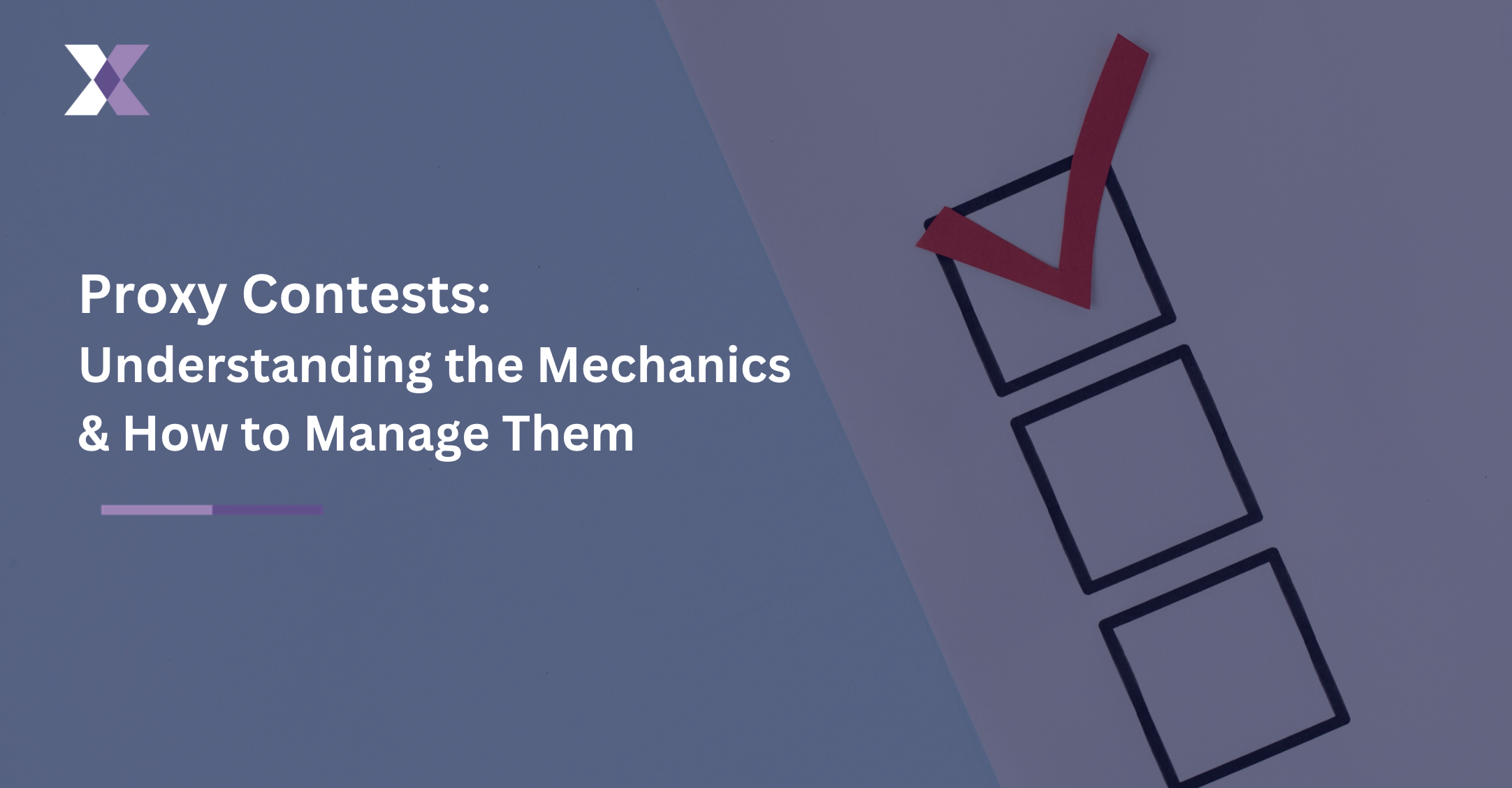Views
Proxy Contests: Understanding the Mechanics and How to Manage Them

Proxy contests are pivotal events in corporate governance, often shaping the future of companies and their management structures. The introduction of new rules that benefit the shareholders has resulted in an increase in shareholder proposals and a fair number of activist campaigns and proxy contests.
For example, last year’s peak AGM season saw nearly 25% of the activist campaigns become contested and proceed to a shareholder vote.
Recent cases highlight shareholders’ influence on corporate decisions and the opportunity for them to campaign against the company’s practices, management, strategy etc. A popular case this year was the contest between Disney and Nelson Peltz’s Trian Partners. Nelson and a few other shareholders were unhappy with the performance of the management and the vetting in the succession planning. While investors sided with Disney, the event showcased the power of shareholders and the significance of activities like proxy contests in shaping corporate actions.
This article delves into the intricacies of proxy contests, exploring their definition, reasons, mechanics, notable examples, and strategies to help issuers avoid or manage them.
What is a Proxy Contest?
A proxy contest, also known as a proxy fight or proxy battle, occurs when shareholders band together to influence a company’s decisions by raising an opposing or campaign against a resolution, often aiming to replace the board or alter policies. In the U.S. proxy contests are governed by the new universal proxy rules and involve raising an opposing or a contesting resolution. For instance, the regulations require the use of a universal proxy card in all contested director elections.
This means that shareholders are presented with a single proxy card listing all candidates, allowing them to mix and match votes between the company’s nominees and the dissident’s nominees. The process involves filing specific notices and adhering to strict timelines to ensure compliance with the SEC’s regulations.
In contrast, proxy contests in most other markets do not involve a universal proxy card. Instead, they typically focus on campaigning to gather enough votes against a resolution or to support an alternative slate of directors.
These contests, typically held during Annual General Meetings (AGMs), reflect shareholder democracy and are used to push for changes to enhance shareholder value. Triggered by dissatisfaction with management, strategic disagreements, or governance issues, proxy contests have become a key tool for shareholder activism, especially with rising ESG concerns.
How Does a Proxy Contest Work?

Proxy contests, or proxy fights, are complex processes that involve a series of strategic steps taken by shareholders to challenge the management or board of directors of a company. Understanding how a proxy contest works can help issuers navigate these contentious battles effectively.
The Process of a Proxy Contest
Initiation:
• Identification of Issues: A proxy contest typically begins when a group of shareholders identify issues with the company’s management or strategic direction. This could involve dissatisfaction with financial performance, governance practices, or specific corporate actions like mergers and acquisitions
• Proposal Development: The dissident shareholders then develop alternative proposals, which may include nominating new board members or proposing new policies. These proposals are formalised and prepared for submission during the company’s annual general meeting (AGM). In other words, this is essentially when a meeting becomes contested.
While these steps occur before the contest itself, they are crucial to understanding what goes behind starting a proxy fight at a meeting.
Campaigning:
• Proxy Solicitation: The dissidents start a campaign to solicit proxy votes from other shareholders. This involves convincing other shareholders to support their proposals instead of those recommended by the current management. Communication methods include direct mail, emails, phone calls, and sometimes public campaigns through media and social platforms.
• SEC Filings: In the U.S., dissident shareholders must file detailed information with the Securities and Exchange Commission (SEC) about their proposals and the proxy contest. This ensures transparency and provides all shareholders with the necessary information to make informed decisions.
Voting:
• Proxy Cards: In the U.S., shareholders receive universal proxy cards that they can use to cast their votes. These cards allow shareholders to vote on the dissident’s proposals or the management’s recommendations without attending the AGM in person.
Unlike other markets, where all proposals are listed on a single card, the U.S. traditionally used separate opposition cards. The use of a universal proxy card in the US aimed to unify this process by requiring issuers to include dissident nominees and proposals. However, some dissidents continued issuing their own cards, believing that listing their nominees first might influence shareholder voting.
• Annual General Meeting: The culmination of a proxy contest is the AGM, where the votes are counted, and the outcome is determined. If the dissidents win the majority of votes, their proposals are adopted, which might include changes in the board of directors or corporate policies.
Costs Involved in a Proxy Battle
Engaging in a proxy contest can be a costly affair for both the dissidents and the incumbent management. The expenses associated with proxy contests include legal fees, communication costs, and the expenses related to soliciting votes.
• Legal Fees: Significant expenses for legal counsel to handle regulatory and litigation matters.
• Communication Costs: High costs for printing, mailing proxy materials, and running ads.
• Consultant Fees: Additional expenses for proxy firms, PR consultants, and financial advisors.
According to research by the Harvard Law School Forum on Corporate Governance, the cost of proxy contests in the U.S. can range from $500,000 to over $20 million, depending on the size of the company and the complexity of the issues involved. The significant financial outlay underscores the high stakes of these corporate battles.
What Might Trigger a Proxy Contest?

Proxy contests can emerge for various reasons, reflecting the diverse interests and concerns of shareholders. Understanding the primary triggers behind these contests is crucial for corporate boards.
Proxy Contests in Businesses
Proxy contests often emerge from disagreements on strategy, management performance, or governance. Shareholders might challenge management if they feel dissatisfied with financial results. Activist shareholders, in particular, use proxy contests to push for changes they believe will enhance shareholder value, such as restructuring, spinning off assets, or revising executive compensation
Proxy Contests with Mergers and Acquisitions
Mergers and acquisitions (M&A) often trigger proxy contests. Shareholders may oppose a deal if they believe it undervalues the company or isn’t in their best interest. They might launch a proxy contest to replace board members with those against the deal. For example, Qualcomm’s shareholders engaged in a proxy contest during Broadcom’s attempted acquisition in 2018.
Proxy Contests with Activist Shareholders
Activist shareholders often spearhead proxy contests to implement changes in corporate governance, environmental policies, or social responsibility initiatives. These investors may target companies with perceived governance deficiencies, such as a lack of board independence, poor transparency, or inadequate shareholder rights. They may also focus on environmental, social, and governance (ESG) issues, pressing for more sustainable business practices or better social responsibility measures. The rise of ESG investing has amplified the role of activist shareholders in initiating proxy contests to promote ethical and sustainable business practices.
Past Examples of Proxy Contests

Proxy contests are significant events that often reshape the leadership and strategy of an issuer. Here are some notable examples from recent years illustrating the dynamics and impacts of proxy contests.
Procter & Gamble & Trian Partners (2017)
One of the most high-profile proxy contests in recent history involved Procter & Gamble (P&G) and the activist investor Nelson Peltz of Trian Partners. In 2017, Peltz sought a seat on P&G’s board, arguing that the company needed to restructure to improve its performance. Despite a highly contentious and expensive campaign, which cost over $60 million, Peltz narrowly lost the initial vote. However, a recount later showed he had won by a slim margin, and he was eventually added to the board.
Guyana Goldfields’ and Shareholders (2019)
Unhappy with the way the business was run by management, a group of shareholders, including former CEO Patrick Sheridan, led a proxy fight due to declining gold reserves as compared to the company’s original estimates at their Aurora mines production site. After a lengthy battle, the company settled with the dissident shareholders, appointing two new independent directors to the board.
Bluebell Capital and Danone (2021)
In Europe, Bluebell Capital Partners reportedly launched a successful proxy contest against the French food giant Danone in 2021. Bluebell criticised Danone’s poor financial performance and governance issues, demanding the removal of the CEO and changes to the board. The campaign led to the resignation of Danone’s CEO and the appointment of new board members, demonstrating the power of shareholder activism even in well-established European firms.
Macellum Advisors and Kohl’s (2022)
In 2022, Macellum Advisors, an activist investor, launched a proxy contest against the retail giant Kohl’s. Macellum criticized Kohl’s for its underperformance and lack of strategic direction, nominating a slate of directors to push for changes. Despite a vigorous campaign, Kohl’s shareholders ultimately sided with the existing board, rejecting Macellum’s nominees. This contest highlighted the ongoing pressures retail brands face from activist investors.
Starbucks and Worker’s Rights Activists (2022-23)
In 2022, Starbucks faced a significant proxy contest led by a coalition of shareholders advocating for enhanced worker rights. The coalition sought better labour practices, focusing on fair wages and improved working conditions. This contest marked a pivotal moment, emphasizing the growing influence of social and governance issues in corporate decision-making. Despite resistance from Starbucks’ management, the contest garnered substantial attention, highlighting the increasing power of shareholder activism in addressing ESG concerns.
These examples highlight the varied drivers, nature and significant impact of proxy contests across different industries and regions.
Recent Examples of Proxy Contests
Servotronics, Inc. & Beaver Hollow Wellness LLC (2025)
In early 2025, Beaver Hollow Wellness, one of Servotronics’ largest shareholders, reportedly launched a proxy contest to nominate four directors to the board. The investor called for an internal investigation into executive compensation and raised concerns about potential unjust enrichment. As tensions escalated, Beaver Hollow publicly opposed Servotronics’ plans to explore a sale, citing risks to local jobs and operations. However, following the announcement of Servotronics’ agreement to be acquired by TransDigm for $110 million in May 2025, Beaver Hollow withdrew its nominations, acknowledging the transaction’s value for shareholders. The acquisition was completed in July 2025.
AstroNova, Inc. & Askeladden Capital Management LLC (2025)
In March 2025, Askeladden Capital, holding a 9.2% stake in AstroNova, reportedly initiated a proxy contest to replace five board members. The firm criticised management for underperformance and the fallout from the MTEX acquisition, which led to debt covenant breaches and a significant goodwill impairment. Proxy advisory firms ISS and Glass Lewis later endorsed Askeladden’s nominees, increasing pressure on the company. After CEO Gregory Woods resigned and the annual meeting was delayed, both parties reached a cooperation agreement in August 2025, with AstroNova appointing one of Askeladden’s nominees to the board.
Are Proxy Contests and Hostile Takeovers the Same?
While both proxy contests and hostile takeovers aim to influence a company’s direction, they differ significantly in strategy, execution, and implications for corporate governance.
A hostile takeover involves an external entity attempting to acquire a company against the wishes of its current management and board. This is usually achieved by directly purchasing a majority of the company’s outstanding shares. Hostile takeovers are often initiated through tender offers, where the acquiring company proposes to buy shares from shareholders at a premium price, or through a proxy fight to replace the board and gain control indirectly.
The primary difference between proxy contests and hostile takeovers lies in their approach and execution. Proxy contests are internal and focus on gaining support from existing shareholders to change company policies or leadership from within. In contrast, hostile takeovers are external and involve acquiring a controlling stake in the company, often leading to significant structural changes.
An example of a hostile takeover is the attempted acquisition of Spirit Airlines by JetBlue in 2022. JetBlue made a direct offer to Spirit’s shareholders, bypassing the company’s management, who opposed the deal. Despite the resistance, JetBlue’s aggressive approach highlighted the typical tactics used in a hostile takeover.
How Can You Avoid or Manage Proxy Contests?

Proxy fights can be disruptive and costly, making it crucial for issuers to prepare for and effectively manage such situations. Below are key strategies to help issuers prepare for and manage proxy fights.
Early Shareholder Engagement
Engaging with shareholders early and consistently is one of the most effective ways to prevent proxy fights. Issuers should strive to build strong relationships with their shareholders through regular communication and transparency throughout the year and not just at the meeting. This involves:
• Regular Updates: Provide consistent updates on the company’s performance, strategic direction, and any significant developments. This transparency builds trust and reduces the likelihood of shareholder dissatisfaction.
• Open Dialogue: Encourage open dialogue with shareholders through quarterly earnings calls, annual meetings, and other forums. Publicise contacts of key board and IR team members to build trust and communication, preventing potential proxy fights.
• Understanding Shareholder Concerns: Regularly solicit feedback from shareholders to understand their concerns and address them proactively. This can prevent small issues from escalating into major disputes.
Proactive Governance Practices
Taking care of the top governance issues can also help prevent proxy contests. This includes:
• Board Composition: Ensure the board of directors comprises individuals with diverse skills and backgrounds. This diversity can enhance the board’s effectiveness and make it more difficult for dissident shareholders to argue for changes. This was evidenced by a recent study, highlighting diverse educational backgrounds and experience had a positive effect on investment decision-making.
• Regular Evaluations: Conduct regular evaluations of the board and management team to ensure they are performing effectively. This demonstrates a commitment to accountability and continuous improvement. If feasible, collecting regular feedback from your shareholders on the performance of the board members can help keep them in check.
• Transparent Policies: Maintain transparent policies on executive compensation, succession planning, and other governance matters. Clear and fair policies can reduce the likelihood of shareholder activism.
Real-Time Tracking and Communication
During a proxy contest, real-time tracking of votes and effective communication with shareholders are critical. Issuers should:
• Know your Shareholder Base & Monitor Voting: Having an updated record of your shareholder base and keeping track of voting trends on past and current resolutions can help understand the expectations of your shareholder base and modify strategies accordingly. By monitoring voting trends, issuers can identify patterns and potential issues early, allowing for timely adjustments to their approach. Additionally, this practice provides an early opportunity to reach out to potential activist shareholders to understand their demands and manage expectations.
Digital Tools like Proxymity’s Shareholder Insights Suite are invaluable in this regard. Shareholder Insights offers an updated record of your shareholder base within 24 hours of disclosure distribution for authenticated requests. Furthermore, real-time access to voting data and insights into shareholder behaviours help issuers stay informed and proactive. By leveraging these insights, issuers can tailor their communication strategies and engage more effectively with their shareholder base, thereby reducing the risk or the damage of a proxy fight.
• Engage Effectively and Regularly: Keep shareholders engaged about the company’s position and the implications of the proxy contest. Clear and timely communication can help manage expectations and garner support. Follow the year-round approach to engaging with your shareholders – well before the meeting, during the voting period and after the meeting. The more engaged shareholders are with the company, the lower the risk of a proxy fight.
Legal and Advisory Considerations
Implementing advance notice provisions can prevent unexpected shareholder proposals at meetings. This entails requiring shareholders to provide written notice of proposals, including board nominations, 90-120 days before the meeting.
Additionally, issuers should consider supermajority voting provisions to amend certain bylaws, ensuring significant shareholder consensus. Furthermore, issuers must protect directors and officers through indemnification agreements, providing expense advancements during litigations. Engaging experienced legal and financial advisors is crucial for developing these defenses and maintaining shareholder relations.
Crisis Management Plan
Establishing a crisis management plan involves designating a small team, including senior officers, financial advisors, and legal counsel, to plan and respond to activist stockholders. This team should meet regularly and retain a proxy solicitor to monitor trading activities and provide real-time alerts. In the U.S., monitoring SEC filings and Hart-Scott-Rodino notifications can offer early warnings of potential threats.
Additionally, the team should prepare detailed responses, Q&A guides, and enforce a “no comment” policy on certain agreed upon issues to prevent miscommunications. They need to ensure the company has a deep understanding of stockholder sentiment and key issues in the market and is able to address hot-button issues with compelling narratives to sway voters.
Designating the CEO or the Head of the Investor Relations team as the spokesperson for strategic matters can further manage and control the company’s communications effectively while building trust among shareholders.
Strengthening Shareholder Relations Post-Contest
After a proxy contest, it’s important to mend any strained relationships with shareholders and strengthen ongoing engagement efforts. Strategies may include:
• Post-Contest Review: Conduct a thorough review of the proxy contest to identify lessons learned and areas for improvement. This review can help prevent future disputes and enhance the company’s governance practices.
• Ongoing Engagement: Continue to engage with shareholders regularly, even after the proxy contest has been resolved. Building a culture of continuous engagement and transparency can foster long-term shareholder loyalty.
These strategies not only help avoid proxy fights but also strengthen the overall relationship with shareholders, fostering a stable and supportive shareholder base.
Learn More Ways to Avoid or Manage Proxy Contests

Proxy contests are complex and pivotal events in corporate governance, often driven by shareholder dissatisfaction, strategic disagreements, or governance issues. These contests can reshape leadership and corporate strategies.
Proactive engagement and communication with shareholders are key to avoiding proxy fights. In the digital age, leveraging advanced technology for data analytics and efficiency is crucial to minimize damages and run successful campaigns.
Proxymity Vote Connect addresses legacy system challenges, enhancing governance and stewardship. It offers live vote tracking and real-time communication, converting days into minutes, allowing issuers to engage more effectively with shareholders and reduce proxy fight risks.
To learn more about how Proxymity can help you manage proxy contests and improve your corporate governance practices, contact us today.
